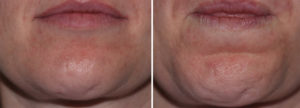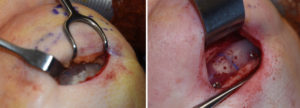Background: Chin implants are well known to induce a variety of tissue reactions around the implant site. A surrounding encapsulation of scar tissue is always seen as occurs in every synthetic implant placed in the body. ‘Bone resorption‘ is often cited as an adverse reaction to chin implants but this is a misinterpretation of the actual biologic response that has occurred. It is more accurately described as a limited and passive bone remodeling as a response to the recoil of the expanded tight chin pad tissues now overlying the implant. It is, in effect, a pressure relief.
Some limited bone overgrowth around the edges of the implant is also not uncommonly seen. This occurs because the implant is placed in a subperiosteal location from which a limited osteogenic response is seen from the disturbed periosteal layer. It is actually rather remarkable that bone would grow up over portions of the implant given that it is a synthetic material. But this speaks to the osteogenic potential of the periosteum. But when such a bony overgrowth is seen it is limited to just the edge of the implant, usually the lower edge.


Complete bony overgrowth of an extended chin implant is a tissue reaction that I have not seen occur. Partial bony overgrowth occasionally occurs but never complete bony encasement. Such a bony reaction to the implant could be the source of the overlying soft tissue chin pad indentations due to tethering into the tissues. It remains to be seen if removal of the bone improves these indentations.
It is important in treating chin implant asymmetry that any impedance to the wings of the implant be released/removed to allow the total implant to have achieve a completely horizontal orientation. Usually this involves a release of the surrounding scar capsule. In this case it involved all raised bony edges.
Highlights:
- Chin implants often induce local tissue reactions including bone overgrowth.
- Complete bony encasement of a silicone chin implant is not an implant reaction that I have seen previously.
- Chin implant asymmetry correction requires that all surrounding bony overgrowth must be removed.
Dr. Barry Eppley
Indianapolis, Indiana


